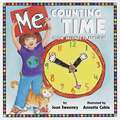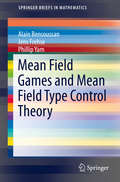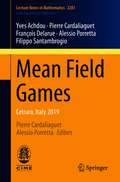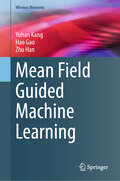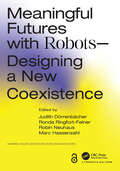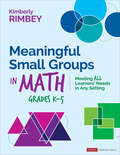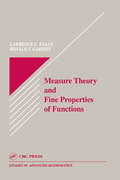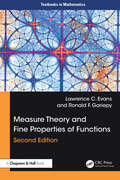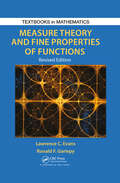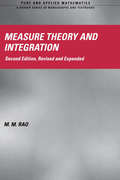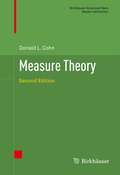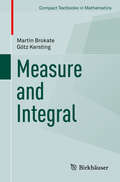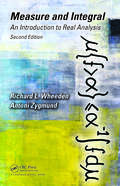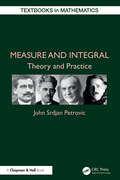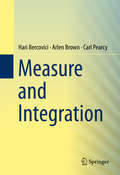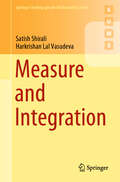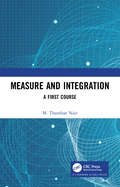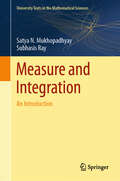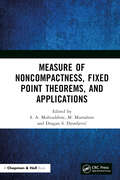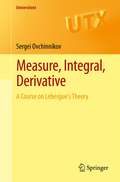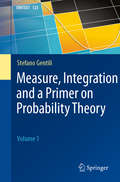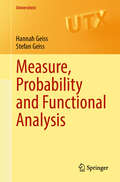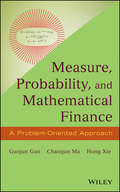- Table View
- List View
Me Counting Time: From Seconds to Centuries
by Joan SweeneyHow long is a second? Can you count a minute? What is a decade? How many years are in a century?Me Counting Time can show you! From a second to a minute to an hour to a day — and all the way to a millennium — this playful introduction to time helps children understand the many measurements of time and how they’re used in everyday life. Easy to read and easy to understand, Me Counting Time makes learning a fun time for every child.
Mean Field Games and Mean Field Type Control Theory
by Alain Bensoussan Jens Frehse Phillip YamMean field games and Mean field type control introduce new problems in Control Theory. The terminology "games" may be confusing. In fact they are control problems, in the sense that one is interested in a single decision maker, whom we can call the representative agent. However, these problems are not standard, since both the evolution of the state and the objective functional is influenced but terms which are not directly related to the state or the control of the decision maker. They are however, indirectly related to him, in the sense that they model a very large community of agents similar to the representative agent. All the agents behave similarly and impact the representative agent. However, because of the large number an aggregation effect takes place. The interesting consequence is that the impact of the community can be modeled by a mean field term, but when this is done, the problem is reduced to a control problem.
Mean Field Games: Cetraro, Italy 2019 (Lecture Notes in Mathematics #2281)
by Pierre Cardaliaguet Yves Achdou Filippo Santambrogio François Delarue Alessio PorrettaThis volume provides an introduction to the theory of Mean Field Games, suggested by J.-M. Lasry and P.-L. Lions in 2006 as a mean-field model for Nash equilibria in the strategic interaction of a large number of agents. Besides giving an accessible presentation of the main features of mean-field game theory, the volume offers an overview of recent developments which explore several important directions: from partial differential equations to stochastic analysis, from the calculus of variations to modeling and aspects related to numerical methods. Arising from the CIME Summer School "Mean Field Games" held in Cetraro in 2019, this book collects together lecture notes prepared by Y. Achdou (with M. Laurière), P. Cardaliaguet, F. Delarue, A. Porretta and F. Santambrogio.These notes will be valuable for researchers and advanced graduate students who wish to approach this theory and explore its connections with several different fields in mathematics.
Mean Field Guided Machine Learning (Wireless Networks)
by Zhu Han Hao Gao Yuhan KangThis book explores the integration of Mean Field Game (MFG) theory with machine learning (ML), presenting both theoretical foundations and practical applications. Drawing from extensive research, it provides insights into how MFG can improve various ML techniques, including supervised learning, reinforcement learning, and federated learning. MFG theory and ML are converging to address critical challenges in high-dimensional spaces and multi-agent systems. While ML has transformed industries by leveraging vast data and computational power, scalability and robustness remain key concerns. MFG theory, which models large populations of interacting agents, offers a mathematical framework to simplify and optimize complex systems, enhancing ML&’s efficiency and applicability. By bridging these two fields, this book aims to drive innovation in scalable and robust machine learning. The integration of MFG with ML not only expands research possibilities but also paves the way for more adaptive and intelligent systems. Through this work, the authors hope to inspire further exploration and development in this promising interdisciplinary domain. With case studies and real-world examples, this book serves as a guide for researchers and students in communications and networks seeking to harness MFG&’s potential in advancing ML. Industry managers, practitioners and government research workers in the fields of communications and networks will find this book a valuable resource as well.
Meaningful Futures with Robots: Designing a New Coexistence (Chapman & Hall/CRC Artificial Intelligence and Robotics Series)
by Marc Hassenzahl Judith Dörrenbächer Ronda Ringfort-Felner Robin NeuhausSoon, robots will leave the factories and make their way into living rooms, supermarkets, and care facilities. They will cooperate with humans in everyday life, taking on more than just practical tasks. How should they communicate with us? Do they need eyes, a screen, or arms? Should they resemble humans? Or may they enrich social situations precisely because they act so differently from humans? Meaningful Futures with Robots: Designing a New Coexistence provides insight into the opportunities and risks that arise from living with robots in the future, anchored in current research projects on everyday robotics. As well as generating ideas for robot developers and designers, it also critically discusses existing theories and methods for social robotics from different perspectives - ethical, design, artistical and technological – and presents new approaches to meaningful human-robot interaction design. Key Features: Provides insights into current research on robots from different disciplinary angles with a particular focus on a value-driven design. Includes contributions from designers, psychologists, engineers, philosophers, artists, and legal scholars, among others.
Meaningful Small Groups in Math, Grades K-5: Meeting All Learners’ Needs in Any Setting (Corwin Mathematics Series)
by Kimberly Ann RimbeyTarget the Math…Support the Students…Provide Access for All The need for focused small group math instruction has never been greater. Today’s education landscape is fraught with learning divides unlike anything we’ve faced in recent years. We need new ways of teaching students who have remarkably varying levels of understanding and vastly different needs. Meaningful Small Groups in Math, Grades K-5 offers practical guidance on how to meet the diverse needs of today’s students. Written for K-5 classroom teachers, math interventionists and instructional coaches, this user-friendly, accessible book provides guidance on the necessary components of small group instruction in math, trajectories for small-group instruction on specific concepts, and practical steps for getting started. Readers will find Checklists and templates for implementing small group, sample lessons in the major content domains Emphasis on flexible groups Intervention and extension ideas for differentiating learning A chapter devoted to developing small-group programs across a school or organization Small group instruction in mathematics has not been as well-developed as its counterpart in the reading world. In K-5 math classrooms, small-group instruction has typically been reduced to learning centers and rotation stations, with little emphasis on differentiated, small-group, teacher-facilitated learning. To meet the needs of today’s students, a more focused approach is needed.
Meaningful Small Groups in Math, Grades K-5: Meeting All Learners’ Needs in Any Setting (Corwin Mathematics Series)
by Kimberly Ann RimbeyTarget the Math…Support the Students…Provide Access for All The need for focused small group math instruction has never been greater. Today’s education landscape is fraught with learning divides unlike anything we’ve faced in recent years. We need new ways of teaching students who have remarkably varying levels of understanding and vastly different needs. Meaningful Small Groups in Math, Grades K-5 offers practical guidance on how to meet the diverse needs of today’s students. Written for K-5 classroom teachers, math interventionists and instructional coaches, this user-friendly, accessible book provides guidance on the necessary components of small group instruction in math, trajectories for small-group instruction on specific concepts, and practical steps for getting started. Readers will find Checklists and templates for implementing small group, sample lessons in the major content domains Emphasis on flexible groups Intervention and extension ideas for differentiating learning A chapter devoted to developing small-group programs across a school or organization Small group instruction in mathematics has not been as well-developed as its counterpart in the reading world. In K-5 math classrooms, small-group instruction has typically been reduced to learning centers and rotation stations, with little emphasis on differentiated, small-group, teacher-facilitated learning. To meet the needs of today’s students, a more focused approach is needed.
Measure Theory and Fine Properties of Functions (Studies In Advanced Mathematics Ser. #5)
by LawrenceCraig EvansThis book provides a detailed examination of the central assertions of measure theory in n-dimensional Euclidean space and emphasizes the roles of Hausdorff measure and the capacity in characterizing the fine properties of sets and functions. Topics covered include a quick review of abstract measure theory, theorems and differentiation in Mn, lower Hausdorff measures, area and coarea formulas for Lipschitz mappings and related change-of-variable formulas, and Sobolev functions and functions of bounded variation. The text provides complete proofs of many key results omitted from other books, including Besicovitch's Covering Theorem, Rademacher's Theorem (on the differentiability a.e. of Lipschitz functions), the Area and Coarea Formulas, the precise structure of Sobolev and BV functions, the precise structure of sets of finite perimeter, and Alexandro's Theorem (on the twice differentiability a.e. of convex functions).Topics are carefully selected and the proofs succinct, but complete, which makes this book ideal reading for applied mathematicians and graduate students in applied mathematics.
Measure Theory and Fine Properties of Functions (Textbooks in Mathematics)
by Lawrence C. EvansThis popular textbook provides a detailed examination of the central assertions of measure theory in n-dimensional Euclidean space, with emphasis upon the roles of Hausdorff measure and capacity in characterizing the fine properties of sets and functions.Measure Theory and Fine Properties of Functions, Second Edition includes many interesting items working mathematical analysts need to know, but are rarely taught. Topics covered include a review of abstract measure theory, including Besicovitch’s covering theorem, Rademacher’s theorem (on the differentiability a.e. of Lipschitz continuous functions), the area and coarea formulas, the precise structure of Sobolev and BV functions, the precise structure of sets of finite perimeter, and Aleksandrov’s theorem (on the twice differentiability a.e. of convex functions).The topics are carefully selected, and the proofs are succinct, but complete. This book provides ideal reading for mathematicians and graduate students in pure and applied mathematics. The authors assume readers are at least fairly conversant with both Lebesgue measure and abstract measure theory, and the expository style reflects this expectation. The book does not offer lengthy heuristics or motivation, but as compensation presents all the technicalities of the proofs.This new Second Edition has been updated to provide corrections and minor edits from the previous Revised Edition, with countless improvements in notation, format and clarity of exposition. Also new is a section on the sub differentials of convex functions, and in addition the bibliography has been updated.
Measure Theory and Fine Properties of Functions, Revised Edition (Textbooks in Mathematics)
by Lawrence Craig Evans Ronald F. GariepyThis book emphasizes the roles of Hausdorff measure and the capacity in characterizing the fine properties of sets and functions. The book covers theorems and differentiation in Rn , Hausdorff measures, area and coarea formulas for Lipschitz mappings and related change-of-variable formulas, and Sobolev functions and functions of bounded variation. This second edition includes countless improvements in notation, format, and clarity of exposition. Also new are several sections describing the p- theorem, weak compactness criteria in L1, and Young measure methods for weak convergence. In addition, the bibliography has been updated.
Measure Theory and Integration (Chapman & Hall/CRC Pure and Applied Mathematics #Vol. 266)
by M. M. RaoSignificantly revised and expanded, this authoritative reference/text comprehensively describes concepts in measure theory, classical integration, and generalized Riemann integration of both scalar and vector types-providing a complete and detailed review of every aspect of measure and integration theory using valuable examples, exercises, and applications.With more than 170 references for further investigation of the subject, this Second Editionprovides more than 60 pages of new information, as well as a new chapter on nonabsolute integralscontains extended discussions on the four basic results of Banach spacespresents an in-depth analysis of the classical integrations with many applications, including integration of nonmeasurable functions, Lebesgue spaces, and their propertiesdetails the basic properties and extensions of the Lebesgue-Carathéodory measure theory, as well as the structure and convergence of real measurable functionscovers the Stone isomorphism theorem, the lifting theorem, the Daniell method of integration, and capacity theoryMeasure Theory and Integration, Second Edition is a valuable reference for all pure and applied mathematicians, statisticians, and mathematical analysts, and an outstanding text for all graduate students in these disciplines.
Measure Theory: Second Edition
by Donald L. CohnIntended as a self-contained introduction to measure theory, this textbook also includes a comprehensive treatment of integration on locally compact Hausdorff spaces, the analytic and Borel subsets of Polish spaces, and Haar measures on locally compact groups. This second edition includes a chapter on measure-theoretic probability theory, plus brief treatments of the Banach-Tarski paradox, the Henstock-Kurzweil integral, the Daniell integral, and the existence of liftings. Measure Theory provides a solid background for study in both functional analysis and probability theory and is an excellent resource for advanced undergraduate and graduate students in mathematics. The prerequisites for this book are basic courses in point-set topology and in analysis, and the appendices present a thorough review of essential background material.
Measure and Integral
by Martin Brokate Götz KerstingThe Lebesgue integral is an essential tool in the fields of analysis and stochastics and for this reason, in many areas where mathematics is applied. This textbook is a concise, lecture-tested introduction to measure and integration theory. It addresses the important topics of this theory and presents additional results which establish connections to other areas of mathematics. The arrangement of the material should allow the adoption of this textbook in differently composed Bachelor programmes.
Measure and Integral: An Introduction to Real Analysis, Second Edition (Chapman & Hall/CRC Pure and Applied Mathematics)
by Richard L. WheedenNow considered a classic text on the topic, Measure and Integral: An Introduction to Real Analysis provides an introduction to real analysis by first developing the theory of measure and integration in the simple setting of Euclidean space, and then presenting a more general treatment based on abstract notions characterized by axioms and with less
Measure and Integral: Theory and Practice (Textbooks in Mathematics)
by John Srdjan PetrovicThis accessible introduction to the topic covers the theory of measure and integral, as introduced by Lebesgue and developed in the first half of the 20th century. It leads naturally to Banach spaces of functions and linear operators acting on them.This material in Measure and Integral: Theory and Practice is typically covered in a graduate course and is almost always treated in an abstract way, with little or no motivation. The author employs a plethora of examples and exercises and strives to motivate every concept with its historical background. This textbook is accessible to a wider range of students, including at the undergraduate level.A major problem facing anyone teaching measure theory is how to combine the elementary approach (measure on the real line or in the plane) and the abstract measure theory. The author develops a theory of measure in the plane, then shows how to generalize these ideas to an abstract setting.The result is a textbook accessible to a wider range of students.The material requires a good understanding of topics often referred to as advanced calculus, such as Riemann integration on Euclidean spaces and series of functions. Also, a reader is expected to be proficient in the basics of set theory and point-set topology, preferably including metric spaces.
Measure and Integration
by Hari Bercovici Arlen Brown Carl PearcyThis book covers the material of a oneyear course in real analysis. It includes an original axiomatic approachto Lebesgue integration which the authors have found to be effective in theclassroom. Each chapter contains numerous examples and an extensiveproblem set which expands considerably the breadth of the material covered inthe text. Hints are included for some of the more difficult problems.
Measure and Integration (Springer Undergraduate Mathematics Series)
by Harkrishan Lal Vasudeva Satish ShiraliThis textbook provides a thorough introduction to measure and integration theory, fundamental topics of advanced mathematical analysis.Proceeding at a leisurely, student-friendly pace, the authors begin by recalling elementary notions of real analysis before proceeding to measure theory and Lebesgue integration. Further chapters cover Fourier series, differentiation, modes of convergence, and product measures. Noteworthy topics discussed in the text include Lp spaces, the Radon–Nikodým Theorem, signed measures, the Riesz Representation Theorem, and the Tonelli and Fubini Theorems.This textbook, based on extensive teaching experience, is written for senior undergraduate and beginning graduate students in mathematics. With each topic carefully motivated and hints to more than 300 exercises, it is the ideal companion for self-study or use alongside lecture courses.
Measure and Integration: A First Course
by M Thamban NairThis concise text is intended as an introductory course in measure and integration. It covers essentials of the subject, providing ample motivation for new concepts and theorems in the form of discussion and remarks, and with many worked-out examples. The novelty of Measure and Integration: A First Course is in its style of exposition of the standard material in a student-friendly manner. New concepts are introduced progressively from less abstract to more abstract so that the subject is felt on solid footing. The book starts with a review of Riemann integration as a motivation for the necessity of introducing the concepts of measure and integration in a general setting. Then the text slowly evolves from the concept of an outer measure of subsets of the set of real line to the concept of Lebesgue measurable sets and Lebesgue measure, and then to the concept of a measure, measurable function, and integration in a more general setting. Again, integration is first introduced with non-negative functions, and then progressively with real and complex-valued functions. A chapter on Fourier transform is introduced only to make the reader realize the importance of the subject to another area of analysis that is essential for the study of advanced courses on partial differential equations. Key Features Numerous examples are worked out in detail. Lebesgue measurability is introduced only after convincing the reader of its necessity. Integrals of a non-negative measurable function is defined after motivating its existence as limits of integrals of simple measurable functions. Several inquisitive questions and important conclusions are displayed prominently. A good number of problems with liberal hints is provided at the end of each chapter. The book is so designed that it can be used as a text for a one-semester course during the first year of a master's program in mathematics or at the senior undergraduate level. About the Author M. Thamban Nair is a professor of mathematics at the Indian Institute of Technology Madras, Chennai, India. He was a post-doctoral fellow at the University of Grenoble, France through a French government scholarship, and also held visiting positions at Australian National University, Canberra, University of Kaiserslautern, Germany, University of St-Etienne, France, and Sun Yat-sen University, Guangzhou, China. The broad area of Prof. Nair’s research is in functional analysis and operator equations, more specifically, in the operator theoretic aspects of inverse and ill-posed problems. Prof. Nair has published more than 70 research papers in nationally and internationally reputed journals in the areas of spectral approximations, operator equations, and inverse and ill-posed problems. He is also the author of three books: Functional Analysis: A First Course (PHI-Learning, New Delhi), Linear Operator Equations: Approximation and Regularization (World Scientific, Singapore), and Calculus of One Variable (Ane Books Pvt. Ltd, New Delhi), and he is also co-author of Linear Algebra (Springer, New York).
Measure and Integration: An Introduction (University Texts in the Mathematical Sciences)
by Subhasis Ray Satya N. MukhopadhyayDesigned for senior undergraduate and graduate students in mathematics, this textbook offers a comprehensive exploration of measure theory and integration. It acts as a pivotal link bridging the Riemann integral and the Lebesgue integral, with a primary focus on tracing the evolution of measure and integration from their historical roots. A distinctive feature of the book is meticulous guidance, providing a step-by-step journey through the subject matter, thus rendering complex concepts more accessible to beginners. A fundamental grasp of differential and integral calculus, as well as Riemann integration, is recommended to ensure a smoother comprehension of the material. This textbook comprises 10 well-structured chapters, each thoughtfully organized to lead students from fundamental principles to advanced complexities. Beginning with the establishment of Lebesgue’s measure on the real line and an introduction to measurable functions, the book then delves into exploring the cardinalities of various set classes. As readers progress, the subtleties of the Lebesgue integral emerge, showcasing its generalization of the Riemann integral and its unique characteristics in higher dimensions. One of the book’s distinctive aspects is its indepth comparison of the Lebesgue integral, improper Riemann integral, and Newton integral, shedding light on their distinct qualities and relative independence. Subsequent chapters delve into the realm of general measures, Lebesgue-Stieltje's measure, Hausdorff ’s measure, and the concept of measure and integration in product spaces. Furthermore, the book delves into function spaces, such as 𝘓𝘱 spaces, and navigates the intricacies of signed and complex measures, providing students with a comprehensive foundation in this vital area of mathematics.
Measure of Noncompactness, Fixed Point Theorems, and Applications
by M. Mursaleen S. A. Mohiuddine Dragan S. DjordjevićThe theory of the measure of noncompactness has proved its significance in various contexts, particularly in the study of fixed point theory, differential equations, functional equations, integral and integrodifferential equations, optimization, and others. This edited volume presents the recent developments in the theory of the measure of noncompactness and its applications in pure and applied mathematics. It discusses important topics such as measures of noncompactness in the space of regulated functions, application in nonlinear infinite systems of fractional differential equations, and coupled fixed point theorem.Key Highlights: Explains numerical solution of functional integral equation through coupled fixed point theorem, measure of noncompactness and iterative algorithm Showcases applications of the measure of noncompactness and Petryshyn’s fixed point theorem functional integral equations in Banach algebra Explores the existence of solutions of the implicit fractional integral equation via extension of the Darbo’s fixed point theorem Discusses best proximity point results using measure of noncompactness and its applications Includes solvability of some fractional differential equations in the holder space and their numerical treatment via measures of noncompactness This reference work is for scholars and academic researchers in pure and applied mathematics.
Measure, Integral, Derivative
by Sergei OvchinnikovThis classroom-tested text is intended for a one-semester course in Lebesgue's theory. With over 180 exercises, the text takes an elementary approach, making it easily accessible to both upper-undergraduate- and lower-graduate-level students. The three main topics presented are measure, integration, and differentiation, and the only prerequisite is a course in elementary real analysis. In order to keep the book self-contained, an introductory chapter is included with the intent to fill the gap between what the student may have learned before and what is required to fully understand the consequent text. Proofs of difficult results, such as the differentiability property of functions of bounded variations, are dissected into small steps in order to be accessible to students. With the exception of a few simple statements, all results are proven in the text. The presentation is elementary, where σ-algebras are not used in the text on measure theory and Dini's derivatives are not used in the chapter on differentiation. However, all the main results of Lebesgue's theory are found in the book.
Measure, Integration and a Primer on Probability Theory: Volume 1 (UNITEXT #125)
by Stefano GentiliThe text contains detailed and complete proofs and includes instructive historical introductions to key chapters. These serve to illustrate the hurdles faced by the scholars that developed the theory, and allow the novice to approach the subject from a wider angle, thus appreciating the human side of major figures in Mathematics. The style in which topics are addressed, albeit informal, always maintains a rigorous character. The attention placed in the careful layout of the logical steps of proofs, the abundant examples and the supplementary remarks disseminated throughout all contribute to render the reading pleasant and facilitate the learning process. The exposition is particularly suitable for students of Mathematics, Physics, Engineering and Statistics, besides providing the foundation essential for the study of Probability Theory and many branches of Applied Mathematics, including the Analysis of Financial Markets and other areas of Financial Engineering.
Measure, Probability and Functional Analysis (Universitext)
by Hannah Geiss Stefan GeissThis textbook offers a self-contained introduction to probability, covering all topics required for further study in stochastic processes and stochastic analysis, as well as some advanced topics at the interface between probability and functional analysis. The initial chapters provide a rigorous introduction to measure theory, with a special focus on probability spaces. Next, Lebesgue integration theory is developed in full detail covering the main methods and statements, followed by the important limit theorems of probability. Advanced limit theorems, such as the Berry-Esseen Theorem and Stein’s method, are included. The final part of the book explores interactions between probability and functional analysis. It includes an introduction to Banach function spaces, such as Lorentz and Orlicz spaces, and to random variables with values in Banach spaces. The Itô–Nisio Theorem, the Strong Law of Large Numbers in Banach spaces, and the Bochner, Pettis, and Dunford integrals are presented. As an application, Brownian motion is rigorously constructed and investigated using Banach function space methods. Based on courses taught by the authors, this book can serve as the main text for a graduate-level course on probability, and each chapter contains a collection of exercises. The unique combination of probability and functional analysis, as well as the advanced and original topics included, will also appeal to researchers working in probability and related fields.
Measure, Probability, and Mathematical Finance
by Hong Xie Chaoqun Ma Guojun GanAn introduction to the mathematical theory and financial models developed and used on Wall StreetProviding both a theoretical and practical approach to the underlying mathematical theory behind financial models, Measure, Probability, and Mathematical Finance: A Problem-Oriented Approach presents important concepts and results in measure theory, probability theory, stochastic processes, and stochastic calculus. Measure theory is indispensable to the rigorous development of probability theory and is also necessary to properly address martingale measures, the change of numeraire theory, and LIBOR market models. In addition, probability theory is presented to facilitate the development of stochastic processes, including martingales and Brownian motions, while stochastic processes and stochastic calculus are discussed to model asset prices and develop derivative pricing models.The authors promote a problem-solving approach when applying mathematics in real-world situations, and readers are encouraged to address theorems and problems with mathematical rigor. In addition, Measure, Probability, and Mathematical Finance features:A comprehensive list of concepts and theorems from measure theory, probability theory, stochastic processes, and stochastic calculusOver 500 problems with hints and select solutions to reinforce basic concepts and important theoremsClassic derivative pricing models in mathematical finance that have been developed and published since the seminal work of Black and Scholes Measure, Probability, and Mathematical Finance: A Problem-Oriented Approach is an ideal textbook for introductory quantitative courses in business, economics, and mathematical finance at the upper-undergraduate and graduate levels. The book is also a useful reference for readers who need to build their mathematical skills in order to better understand the mathematical theory of derivative pricing models.
Measure-Theoretic Probability: With Applications to Statistics, Finance, and Engineering (Compact Textbooks in Mathematics)
by Kenneth ShumThis textbook offers an approachable introduction to measure-theoretic probability, illustrating core concepts with examples from statistics and engineering. The author presents complex concepts in a succinct manner, making otherwise intimidating material approachable to undergraduates who are not necessarily studying mathematics as their major. Throughout, readers will learn how probability serves as the language in a variety of exciting fields. Specific applications covered include the coupon collector’s problem, Monte Carlo integration in finance, data compression in information theory, and more. Measure-Theoretic Probability is ideal for a one-semester course and will best suit undergraduates studying statistics, data science, financial engineering, and economics who want to understand and apply more advanced ideas from probability to their disciplines. As a concise and rigorous introduction to measure-theoretic probability, it is also suitable for self-study. Prerequisites include a basic knowledge of probability and elementary concepts from real analysis.
